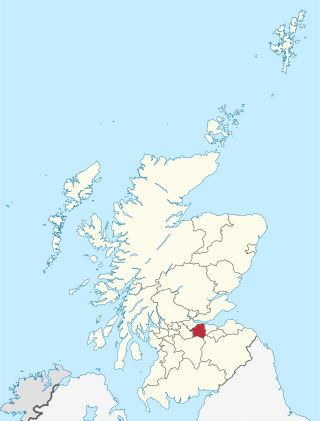
West Lothian is one of the 32 council areas of Scotland, bordering the City of Edinburgh council area, Scottish Borders, South Lanarkshire, North Lanarkshire and Falkirk. The modern council area was formed in 1975 when the historic county of West Lothian, also known as Linlithgowshire, was reshaped substantially as part of local government reforms; some areas that had formerly been part of Midlothian were added to a new West Lothian District within the Region of Lothian, whilst some areas in the north-west were transferred to the Falkirk District and areas in the north-east were transferred to the City of Edinburgh District. In 1996 West Lothian became a unitary authority area, using the same name and territory as in 1975.

Castles are buildings that combine fortifications and residence, and many were built within the borders of modern Scotland. They arrived in Scotland with the introduction of feudalism in the twelfth century. Initially these were wooden motte-and-bailey constructions, but many were replaced by stone castles with a high curtain wall. During the Wars of Independence, Robert the Bruce pursued a policy of castle slighting. In the Late Middle Ages, new castles were built, some on a grander scale as "livery and maintenance" castles that could support a large garrison. Gunpowder weaponry led to the use of gun ports, platforms to mount guns and walls adapted to resist bombardment.

Hopetoun House is a country house near South Queensferry owned by the Hopetoun House Preservation Trust, a charity established in 1974 to preserve the house and grounds as a national monument, to protect and improve their amenities, and to preserve the furniture, paintings, manuscripts, and other articles of historical interest associated with the house. The south wing of the house is occupied by the family of Adrian Hope, 4th Marquess of Linlithgow. The house is a Category A listed building and the grounds are included in the Inventory of Gardens and Designed Landscapes in Scotland.

Abercorn is a village and civil parish in West Lothian, Scotland. Close to the south coast of the Firth of Forth, the village is around 5 km (3.1 mi) west of South Queensferry. The parish had a population of 458 at the 2011 Census.

Morton Castle is located by an artificial loch in the hills above Nithsdale, in Dumfries and Galloway, south-west Scotland. It lies 2.5 miles (4 km) north-east of Thornhill, and once formed part of a chain of castles along the strategically important Nith Valley, which runs from the Solway Firth north to the Clyde Valley.
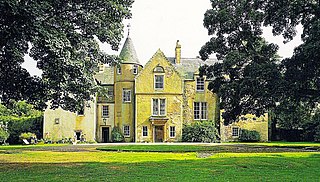
Keith Marischal is a Scottish Baronial Country house lying in the parish of Humbie, East Lothian, Scotland. The original building was an "L-shaped" Tower house, built long before 1589 when it was extended into a "U-shaped" courtyard house. The building acquired its modern appearance in the 19th century when the courtyard was filled in. The house is protected as a category B listed building.

Hawthornden Castle is located on the River North Esk in Midlothian, Scotland. The castle lies a mile to the east of Roslin at grid reference NT287637, and is just downstream from Roslin Castle. Hawthornden comprises a 15th-century ruin, with a 17th-century L-plan house attached. The house has been restored and now serves as a writer's retreat. Man-made caves in the rock beneath the castle have been in use for much longer than the castle itself.

Greenknowe Tower is a 16th-century tower house, located just west of the village of Gordon, in the Scottish Borders. Although a roofless ruin, the stonework of the tower is well preserved, and represents a fine example of a later tower house, built more as a residence rather than as a place of defence. The building is located at NT639428, beside the A6105 road. It is a Scheduled Ancient Monument, and is in the care of Historic Scotland.
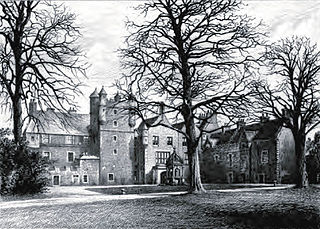
Pinkie House is a historic house, built around a three-storey tower house located in Musselburgh, East Lothian, Scotland. The house dates from the 16th century, was substantially enlarged in the early 17th century, and has been altered several times since. Its location at grid reference NT348726 is to the east of the town centre, on the south side of the High Street. The building now forms part of Loretto School, an independent boarding school. Pinkie House is not far from the site of the disastrous Battle of Pinkie Cleugh, fought in 1547.

Barholm Castle is a tower house located 5 miles (8.0 km) south-west of Gatehouse of Fleet, in Kirkcudbrightshire, Galloway, Scotland. The tower dates back to the late 15th century, and it was a stronghold of a branch of the MacCulloch family. The present form of the castle dates from rebuilding in the 16th or 17th century, and in the early 2000s it was restored from a roofless state to residential use. The tower is sometimes identified with the fictional Ellangowan, in Sir Walter Scott's Guy Mannering.
Hamilton House, also known as Magdalen's House, is a 17th-century "Laird's House" in the town of Prestonpans in East Lothian, Scotland. It is an exemplar of this type of architecture and has retained its crow-stepped gables and corner towers. It is owned by the National Trust for Scotland and is a Category A Listed Building.
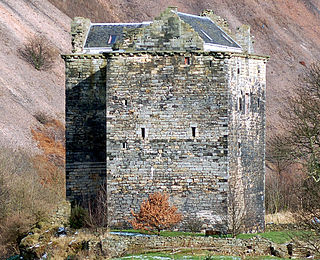
Niddry Castle is a sixteenth-century tower house near Winchburgh, West Lothian, Scotland. It is situated near the Union Canal, and between two large oil shale bings, or waste heaps. Historically it was known as Niddry Seton or West Niddry to distinguish it from Niddry Marischal in Midlothian and Longniddry in East Lothian.
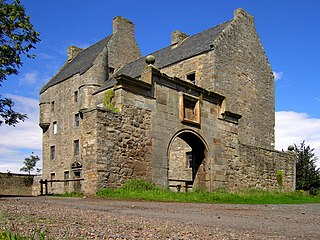
Midhope Castle is a 15th-century tower house in Scotland. It is situated in the hamlet of Abercorn on the Hopetoun estate, About 4 kilometres (2.5 mi) to the west of South Queensferry, on the outskirts of Edinburgh. It is a Category A listed building.

Mavisbank is a country house outside Loanhead, south of Edinburgh in Midlothian, Scotland. It was designed by architect William Adam in collaboration with his client, Sir John Clerk of Penicuik, and was constructed between 1723 and 1727. The first Palladian villa in Scotland, it is described by Historic Scotland as "one of Scotland's most important country houses." It was altered in the 19th century, but suffered decades of neglect in the 20th century. The interiors were gutted by fire in 1973, and the house remains a ruin, described by Colin McWilliam in 1978 as a "precarious shell.". In 2024, a grant of £5.3 million was given to stabilise the building and to enable up-to-date surveys of its condition to be made.
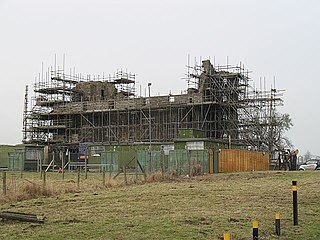
Duntarvie Castle is a ruined Scots Renaissance house in West Lothian, Scotland. It is located 1.5 kilometres (0.93 mi) north of Winchburgh and 9 kilometres (5.6 mi) east of Linlithgow, close to the M9 motorway. Constructed in the late 16th century, the building has been undergoing restoration since the 1990s. The house is protected as a category A listed building, and a scheduled monument.

Murieston Castle is a ruined tower house, dating from the 16th century, 2 miles (3.2 km) west of West Calder, west of the Murieston Water, at Murieston Castle Farm, West Lothian, Scotland. It is a scheduled monument and between 1971 and 2018 it was a Category B listed building.
Abercorn Castle was a 12th-century castle near Abercorn in West Lothian, Scotland.

Illieston House, also known as Illieston Castle, is a castle located in West Lothian, Scotland, by the River Almond near Broxburn. It was built around 1600 and features a T-plan design with gabled dormers and a staircase tower. Over its history, it underwent modifications and restorations, including additions such as a new kitchen wing and modern interior amenities. It has changed ownership several times and it was renovated in 1856 by architect William Burn and underwent modernization in the 21st century. Listed as a Category B building in 1971, it attracted media attention for its sale in 2018.
















